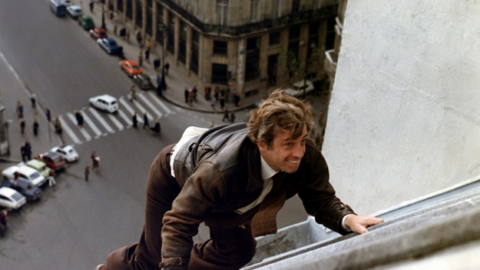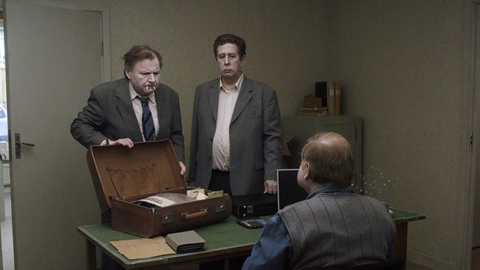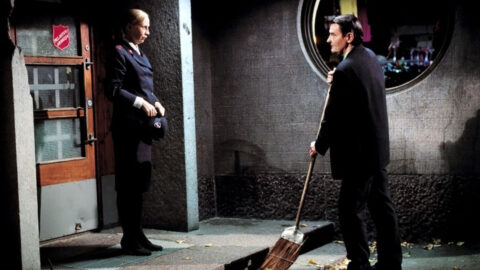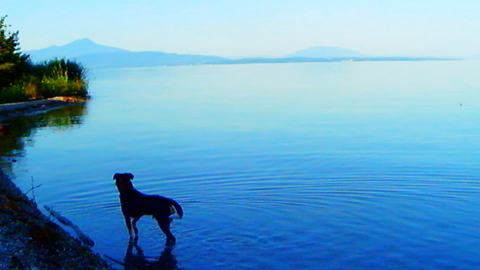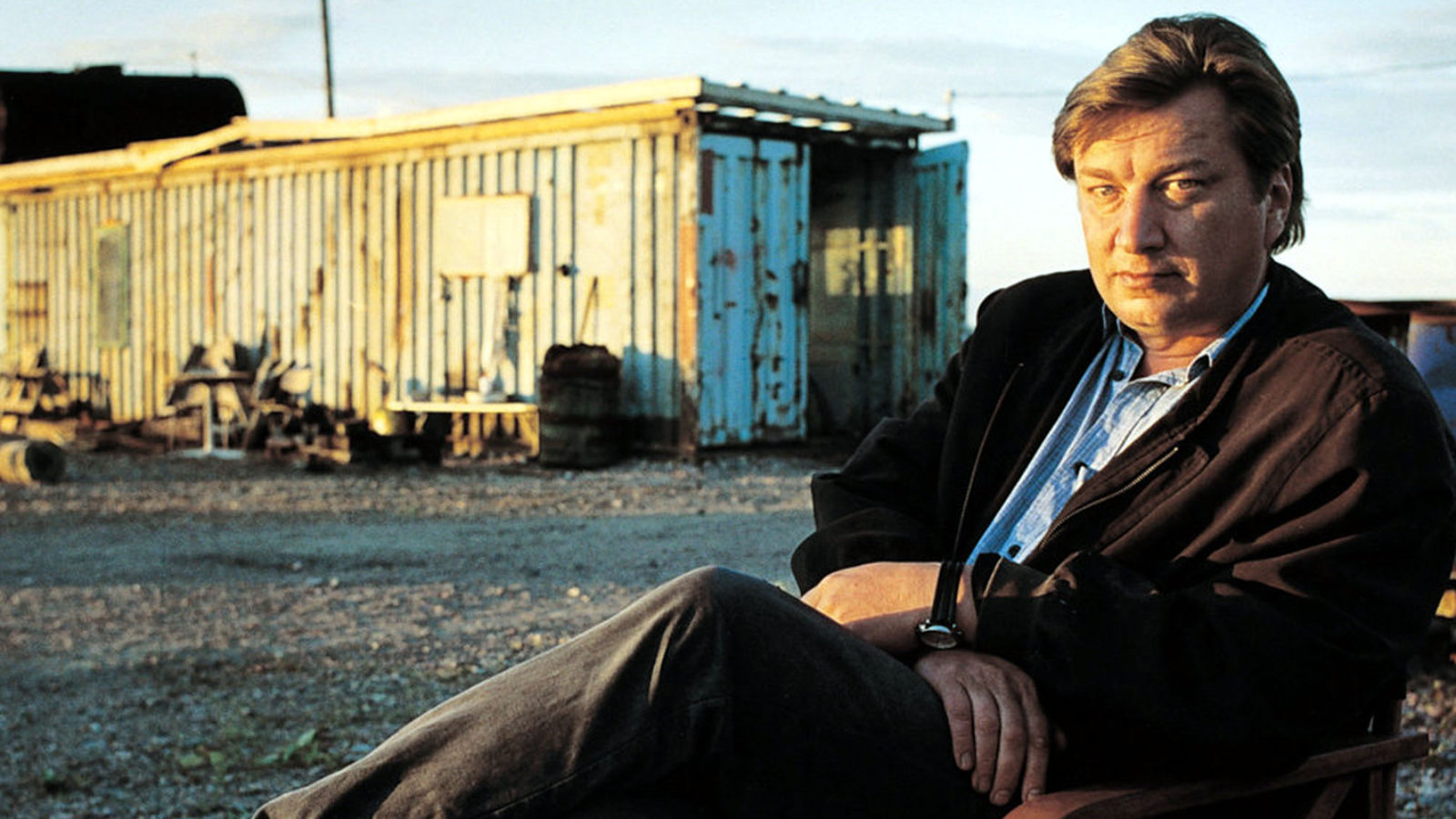
Common People: Aki Kaurismäki
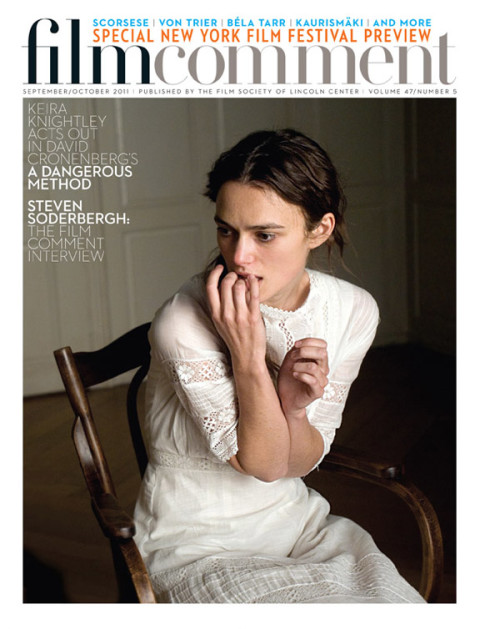
“Money moves in the shadows.”- Le Havre
Chance unites two people as low in the social hierarchy as it gets: French shoeshiner Marcel Marx (André Wilms) and African immigrant boy Idrissa (Blondin Miguel). The youngster has just avoided the fate of his compatriots, evading arrest. He and Marcel appear to be in a giant global trap in which humans are bought and sold—but they prevail, with a little help from the good folk of Le Havre. It’s a fairy tale, like The Man Without a Past, and again made in the spirit of Capra or De Sica or other such humanists who seem to have vanished from the ranks of filmmaking. Likewise, the French cinema’s most profound qualities, long lost, are now improbably resurrected by a Finnish director. Le Havre is naïve and intelligent, intimate and minimalist, with an overwhelming feel for a better world and its possibilities. The great beauty of Aki Kaurismäki’s second French-language film lies in its interconnection of themes: dignity, solidarity, age, and death.
Le Havre initiates Kaurismäki’s third trilogy, which follows on from his two “Loser” trilogies: Shadows in Paradise (1986), Ariel (1988), and The Match Factory Girl (1990), and the trio of visions of a Third World Finland, consisting of Drifting Clouds (1996), The Man Without a Past (2002), and Lights in the Dusk (2006). These are films full of his inimitable brand of humanism, offset by a predominant sense of humor and a disdain for bureaucracy and establishment con men and speculators.
Kaurismäki has also made two particular genres his own. His literary adaptations are free-form dialogues with classic authors that possess not the slightest trace of heavy-handedness, among them Crime and Punishment (1983); Hamlet Goes Business (1987), an almost prophetic vision of a Finland facing impending financial crisis; La vie de bohème (1992); and Juha (1999), one of the few silent films made since the ’30s. And then there are his road movies: the Leningrad Cowboy films, starring “the world’s worst rock ’n’ roll band”; the strange cult film Calamari Union (1985), about an odyssey from one Helsinki district to another (in Jean-Pierre Gorin’s words, “I vitelloni, directed by Dreyer”); and the funniest of all, Take Care of Your Scarf, Tatiana (1994), which depicts a weekend with a pair of country bumpkins who happen upon two girls from neighboring countries, Russia and Estonia.
Drifting Clouds began as a reaction to the 10 percent unemployment rate in Finland: “I couldn’t bear to look at myself in the mirror until I made a film about unemployment,” Kaurismäki said at the time. Now, with Le Havre, he takes the plight of the global working class.
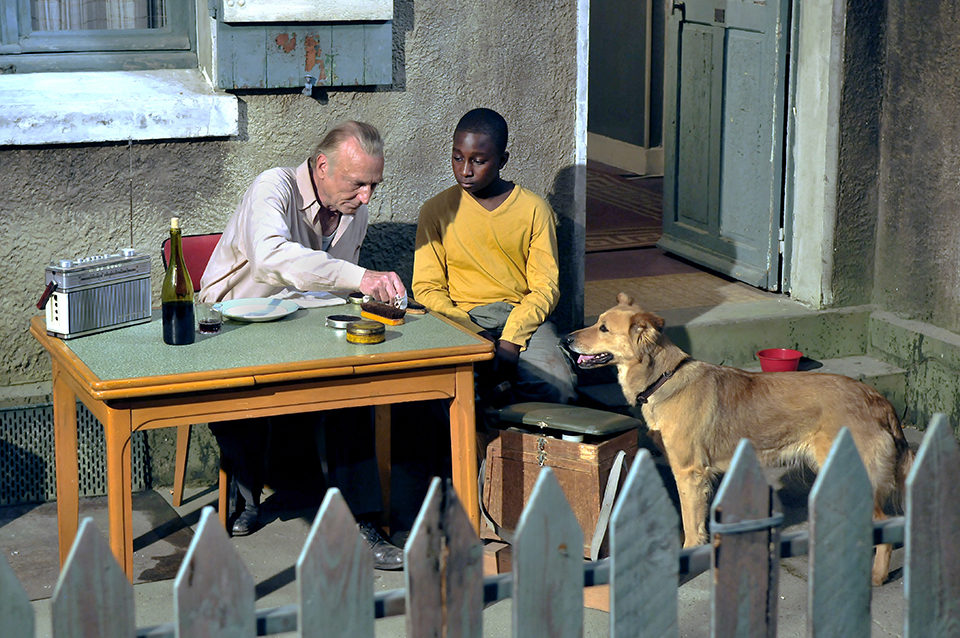
Le Havre (Aki Kaurismaki, 2011)
What poetic logic led you to make your film in a small French town? And why did you make it somewhere else than in Finland?
From the very beginning, the idea was for the main character to be a boat refugee from Africa. Refugees don’t normally come to Finland. At first, I intended to find a suitable Mediterranean seaport. I drove around the coasts of Spain, Portugal, France, and the Bay of Biscay and came close to giving up. Le Havre was just about the last possibility, but then it turned out to be the most authentic.
It’s a bit like a forgotten town, a place barely known by the French themselves. You can’t just accidentally drive past it; you have to make up your mind to go there. Then there’s the historical background. The town was bombed to bits by the Allies as a diversion prior to the D-Day landings in Normandy. The Germans of course occupied Le Havre, but many civilians died and the town was left in ruins. It was rebuilt in the ’50s when the architect Auguste Perret designed the present-day city center as well as every single building and banister.
The small neighborhood where the film’s main characters live was the only one not destroyed in the bombings—and the only one with curvy streets, everything else has been built in an arrow-straight grid plan. But now this particular strip has also been completely demolished. The bulldozers were waiting; we bought the area an extra week of life. As always, the most interesting scenery is destroyed to make room for malls. The process often is that the working people are first driven outside the city, out of sight, and they realize they were driven to the most beautiful place. And then they are turned out of there, too. The corresponding American example is New Orleans—the indifference of the federal state and the exploitation of its “the natural disaster” were shocking.
Le Havre is a completely unique town, I have never seen anything like it. The name derives from the English word “haven,” so the etymology is a “haven of peace.” It has a miraculous light, a hazy whiteness and a microclimate drifting in from the Channel, that has made painters from all over the world go there to capture that strange light.
The earlier famous Le Havre film is Port of Shadows [1938], but of course only relatively because it is very much a studio film.
That side of it is well disguised, it doesn’t seem to be made in a studio at all. A truly magnificent film.
Many associations to the history of French cinema come to the surface in your film. What period it is set in?
The period that any film is set in can always be determined by the cars you see. The fact that people smoke a lot in bars points to 2007 or earlier, but not much earlier. If I consider its style, I guess it attempts to re-create some kind of neorealism in the French style. Vittorio de Sica and Cesare Zavattini are lurking in the background, and then I strive to give its neorealism a Marcel Carné or Jacques Becker tone. The starting point—mine and the town itself—is a complete tabula rasa. One could have made it a Melville-type of film or something like Miracle in Milan, or anything in between. I didn’t choose a genre, I just started to write and it turned out as an unashamedly optimistic fairy tale.
When I write, I almost completely work in terms of my subconscious. I digest the theme of the film and what I know of the basic story. Then I wait for three months for my subconscious to finish its work. My writing is very unanalytical, but the final outcome is a pretty precise script, regardless of whether it’s good or bad. The late Matti Pellonpää used exactly the same method as an actor. I gave him the script and he read it at once. Then he didn’t touch it for three months until just prior to the shooting, mainly to learn the dialogue. He used his subconscious to develop the character and to do all the work, like a lazy man would. His subconscious did all the work that a lesser actor would’ve burdened himself with. I consider the subconscious the most ingenious and cheapest hireling you can have in this line of work.
The stylistic key to the film is a fairy-tale atmosphere, almost in a confusing way.
I was uncertain to the very end whether it would work. There’s no visual splendor, either, since it would only serve to estrange. Above all I wanted everyone to see the people. People are at their best when everything goes wrong. The most noble traits, and the ugliest, are always discovered in a crisis: man’s greatness, man’s baseness. If everything disappears, traits of solidarity and self-sacrifice emerge. Of course, in a film one is allowed to and must exaggerate those best qualities of mankind that you do not see too often.
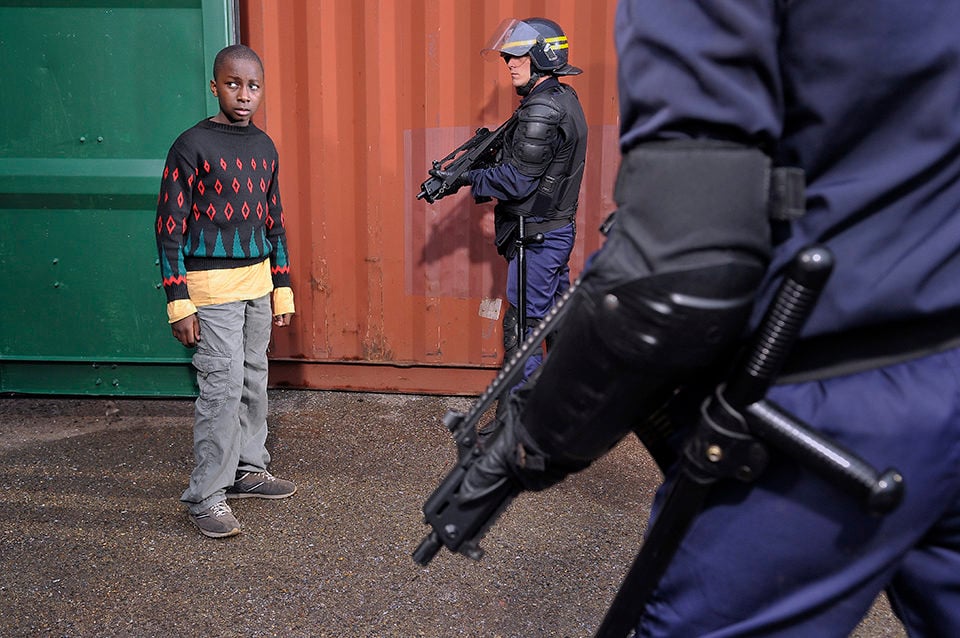
Le Havre (Aki Kaurismaki, 2011)
You seem to have drawn the line at not showing those in power exploiting people, except for some wretched officials.
The Chief of Police is just a voice. That’s a completely conscious choice. I think the right way to show a faceless machine is to not give it a face. Although, as an anecdote, the voice of the Chief of Police is one of the regulars at the Café Moderne we see in the beginning. It is more effective to show faceless power. You must create the atmosphere that they are there, behind the scenes, and that’s it. Perhaps it is the effect of age, but I am not one to turn even police officers into clichés.
There are no evil people in the film, except for the absurd informer. More important than people is the computer error mentioned—the things people are at the mercy of.
I had written that the container with the refugees is filthy, and that some of the immigrants had died. I could not go through with that, and I thought I’d do the complete opposite. Instead, I’d show them wearing their respectable Sunday best—to hell with realism. I’d make them arrive as proud people, instead of having them lie in the container in their own filth, as some of them realistically would have done after two weeks’ incarceration.
One of the characters says there are more identification papers in the Mediterranean than fish. The rule is that many people throw their papers into the sea so they can’t be returned to the country of their origin. We couldn’t use the names of many of the people seen in the film in the end credits because they were real illegal immigrants. They have no official names. I’m certain it must come across that somebody is just being what he is, not doing anything, but just being. Perhaps this is blind trust in cinema, but that’s how it is.
There is an insert of a TV documentary where a refugee center allegedly doesn’t meet adequate standards, and is then razed to the ground, with nothing to replace it. Confronted with problems like this, Europe is plain helpless. There is no other way than to continue this game of ping-pong: people are returned and then they come back again, or new ones take their place. This is understandable from the system’s point of view: if half of Africa comes to a Europe that’s already riddled with unemployment, how could there be work for anyone? The equation is pretty impossible.
At the moment, however, it is clearly a question of abandonment that should be against the Charter of the United Nations. And then in the background lies European colonialism. Why else would Africa be in the state it is other than expressly as the result of the vestiges of colonialism, because Europe drew up arbitrary land borders and caused conflicts that are still present there today? It is the product of the mindless greed when, mostly by the British, bizarre borders were drawn on the map with rulers, in contempt of tribes and traditions. The present-day famines or situations like Darfur are also its consequences.
How do you manage crowd scenes? You’ve claimed you’re bad at them, but you underestimate yourself. While filming The Man Without a Past, during a scene with dozens of amateurs, I saw how little you directed things: the camera was turned on, there were just one or two takes, and the scene is precise as a ballet.
I usually instruct individual people but when dealing with a crowd you just have to somehow get them into the spirit. Crowd scenes are always nerve-racking: you run out of time, the light’s fading, plans fall apart. You almost have no option but to roll the camera and trust your luck. After all, I don’t have any storyboards. The first shot leads to another, and so on. Only when the previous shot is finished I start to plan the next. And I don’t believe storyboards would help. You can lose something because you can’t react to what the scene itself produces. Shots mechanically prepared in advance turn against themselves. The film ends up feeling too well made. Just like when in period films people wear clothes that are too clean, or feature cars that are too shiny.
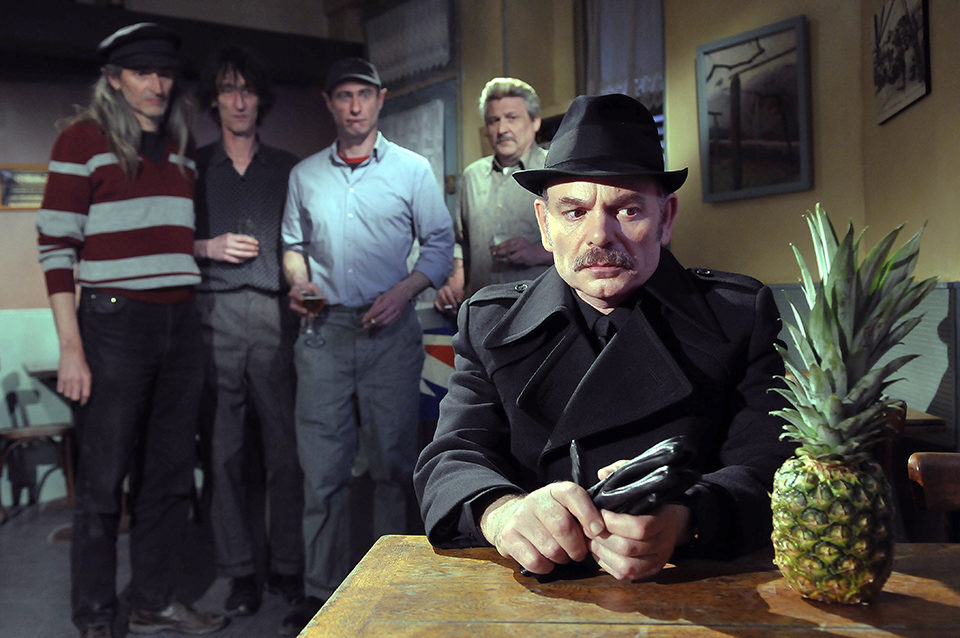
Le Havre (Aki Kaurismaki, 2011)
In several of your films you have had happy and unhappy endings waiting in the wings side by side, before you made your final decision. Was this the case with Le Havre?
No, in this one I thought I’d radically place two happy endings one after the other. It’s seldom done, so I upped the ante: the boy’s departure and the miraculous recovery. Either one would do as a happy ending. The ending might’ve been happy first and then unhappy, but I decided to go full throttle with the fairy-tale aspect. Not even medical science means anything.
One might say that there is a third happy ending, i.e., the final shot that is almost an independent story. An Ozu shot.
It is a perfect Ozu shot, and it’s intended to be. But it is impossible to analyze influences. The head is a big cooking pot in which all ingredients are haphazardly mixed: everything you have experienced, read, seen in films. Then you ladle it out with what I hope is some kind of logic. For instance, blue-gray is my basic set design color, and that is from Melville, and then I may add some red because a red teapot looks good in Ozu’s films. I just use a fire extinguisher because our tea ceremony is so underdeveloped.
The fundamental beauty of the film comes from the way the love story of the old married couple and their fight for self-respect and justice tie into each other. How they are one and the same. The wife lies in the hospital, dying, the husband goes about his business. Just like how in Vigo’s L’Atalante, the finest love scene is the one in which the main characters are not together but dream the same dream.
L’Atalante wasn’t consciously in my mind, but you know that I consider it to be the most beautiful film in the world. I’ve even imported it a couple of times. It is obvious that without the love story one would’ve been forced to toughen up the justice part, and the description of the system would’ve been harsher. The film as a whole would have been a couple degrees crueler.
Three of your films in a row now have centered on the theme of death. The Man Without a Past could be read as the dream of a dying man. The same applies to the ending of Lights in the Dusk: the man is very close to death, but hope arises in the final shot.
It had two endings, one in which the man dies, and another in which he doesn’t. I shot them both, and I used them both. First he dies, and then he takes her hand. But true: the theme does haunt in there; for people in their twenties and thirties, death does not exist at all.
Your previous French film was La vie de bohème. Is there any continuity between these two films?
Perhaps it’s a private joke, but the main character is the same Marcel Marx whose dreams of a successful career as an author in Paris have collapsed. The same bohemian 20 years later. He has, in a way, given up all his hopes. And now he experiences a moral ascent in which, after many years, he starts to take responsibility for something. He has sought the lowest possible rung in society. He could get himself a better occupation and earn more money, but according to his own words, he wants to be closer to the people. When he kneels at people’s feet, that’s where he is most humble.
I came up with the idea of a shoeshiner rescuing an African boy after the shoeshiners all vanished in my Portuguese hometown a few years back. There was one left, and in order to give him some work I had my shoes polished, and when I watched, the rest was easy. When you’re able to place the main character somewhere, all the rest follows automatically—or almost automatically.
I’ll now return to the human faces. The film contains quite a gallery of characters, and one of the most difficult things to shoot: the community of decent people. Or the image of a community unknowingly acting in a spirit of kindness. The supporting roles played by the fine French actors Pierre Étaix, Jean-Pierre Léaud, and Jean-Pierre Darroussin, which seem small at first, are actually extremely emphatic. Darroussin, as a police officer, is almost a dream image of an official who still retains an emotional life.
He has morals. His feelings are not really shown, but they certainly exist. The limited role of the doctor played by Étaix was simply due to the fact that while writing the script I did not know that it would even be possible to have him in the film.
When I asked Léaud to play the main role in I Hired a Contract Killer in 1990, I don’t think he’d been in a leading role for years. I think it was the first film in which he did not in a sense play himself, and this is the case here as well. His role is a small one but hopefully reveals the background: he’s an informer straight out of the world of Clouzot’s The Raven.
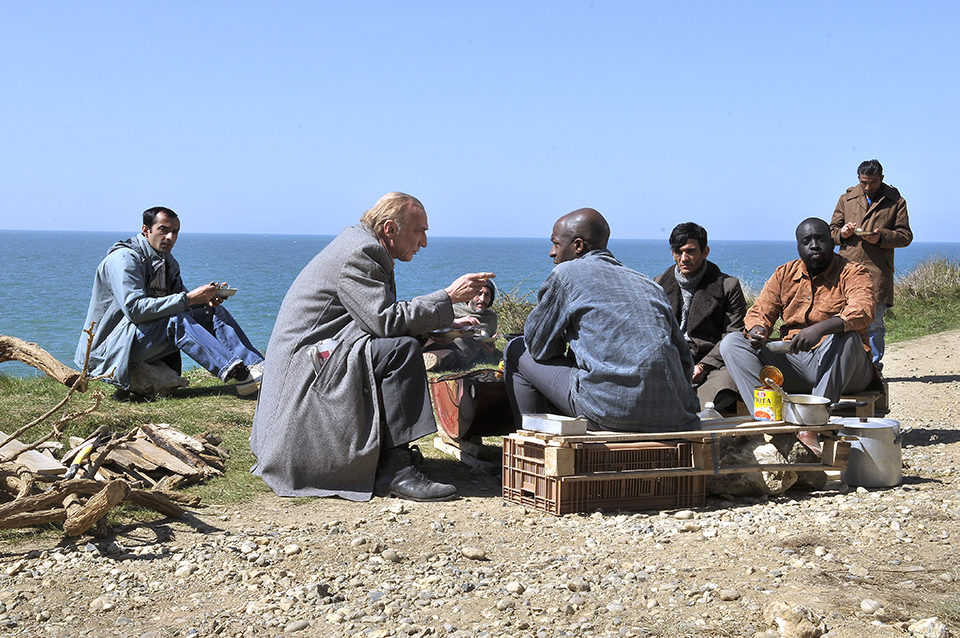
Le Havre (Aki Kaurismaki, 2011)
Was the role of the terminally ill wife part of the original idea?
The idea is an old one. I am going to make a short in Tokyo for an omnibus film. The theme and the miraculous recovery have been taken from there, and are connected to the proprietor of a sake bar I saw in a Tokyo fish market. I added them to the refugee theme that had also been in my mind for years. The fact that the subject matter is very societal, and one that I don’t feel I’m very strong at, partly explains why I ended up with this kind of semi–fairy tale.
There are two characters absolutely at the bottom of the hierarchy. And those whose cards are most stacked against them conquer the laws and regulations and the whole system purporting to support people, while it is something completely else. The theme of death is consistent. That, too, is already dead, there are only these unpretentious people left capable of resistance.
The theme of the outskirts of the town is also close to me. The inhabitants of the outskirts versus downtown. Or the one that almost always comes up with me is a country boy in a big city. The godfather here, too, is Italian neorealism: how the community rises and embraces the refugee boy’s cause. I use outrageous French clichés—a bread shop and accordion music. I’m walking on the edge here but so far the French have so far swallowed it hook, line, and sinker.
There is one more death in the background: the one of cinema. You are one of the few who still hold on to 35mm film.
Real film is light, digital is electricity.
You have said that Le Havre is the beginning of a trilogy. When you are done, you will have 20 films under your belt.
The trilogy will perhaps be completed in 10 years. It’s good to insert a hook like that. If you talk about a trilogy, you can’t stop at two films. And if you have already made two trilogies, you simply must do a third, otherwise it wouldn’t be a trilogy of trilogies.
Will you continue in France?
I’ll make the next one in Spain, and the third one in Germany.
But still not in Portugal, where you live half of the year?
Although I’ve lived there for 20 years now, I still don’t know how the Portuguese think. The most inscrutable nation I’ve ever come across.
This interview appears in an edited and condensed form in the September-October 2011 issue of Film Comment.



